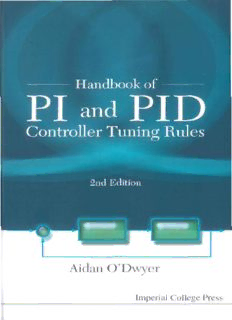
Handbook of Pi And Pid Controller Tuning Rules 2nd edition PDF
Preview Handbook of Pi And Pid Controller Tuning Rules 2nd edition
Handbook of Pi and P ID Controller Tuning Rules 2nd Edition Aidan O*Dwyer Imperial College Press Handbook of PI and P ID Controller Tuning Rules 2nd Edition This page is intentionally left blank Handbook of and PI P ID Controller Tuning Rules 2nd Edition Aidan O'Dwyer Dublin Institute of Technology, Ireland Imperial College Press ICP Published by Imperial College Press 57 Shelton Street Covent Garden London WC2H 9HE Distributed by World Scientific Publishing Co. Pte. Ltd. 5 Toh Tuck Link, Singapore 596224 USA office: 27 Warren Street, Suite 401-402, Hackensack, NJ 07601 UK office: 57 Shelton Street, Covent Garden, London WC2H 9HE British Library Cataloguing-in-Publication Data A catalogue record for this book is available from the British Library. HANDBOOK OF PI AND PID CONTROLLER TUNING RULES (2nd Edition) Copyright © 2006 by Imperial College Press All rights reserved. This book, or parts thereof, may not be reproduced in any form or by any means, electronic or mechanical, including photocopying, recording or any information storage and retrieval system now known or to be invented, without written permission from the Publisher. For photocopying of material in this volume, please pay a copying fee through the Copyright Clearance Center, Inc., 222 Rosewood Drive, Danvers, MA 01923, USA. In this case permission to photocopy is not required from the publisher. ISBN 1-86094-622-4 Printed in Singapore by B & JO Enterprise Dedication Once again, this book is dedicated with love to Angela, Catherine and Fiona and to my parents, Sean and Lillian. This page is intentionally left blank Preface Proportional Integral (PI) and Proportional Integral Derivative (PID) controllers have been at the heart of control engineering practice for seven decades. However, in spite of this, the PID controller has not received much attention from the academic research community until the past fifteen years, when work by K.J. Astrom, T. Hagglund and F.G. Shinskey, among others, has sparked a revival of interest in the use of this "workhorse" of controller implementation. There is strong evidence that PI and PID controllers remain poorly understood and, in particular, poorly tuned in many applications. It is clear that the many controller tuning rules proposed in the literature are not having an impact on industrial practice. One reason is that the tuning rules are not very accessible, being scattered throughout the control literature; in addition, the notation used is not unified. The purpose of this book is to bring together and summarise, using a unified notation, tuning rules for PI and PID controllers. The author restricts the work to tuning rules that may be applied to the control of processes with time delays (dead times); in practice, this is not a significant restriction, as most process models have a time delay term. It is the author's belief that this book will be useful to control and instrument engineering practitioners and will be a useful reference for students and educators in universities and technical colleges. I would like to thank the School of Control Systems and Electrical Engineering, Dublin Institute of Technology, for providing the facilities needed to complete the book. Finally, I am deeply grateful to my mother, Lillian and my father, Sean, for their inspiration and support over many VII viii Handbook of PI and PID Controller Tuning Rules years and to my family Angela, Catherine and Fiona, for their love and understanding. Aidan O'Dwyer Contents Preface vii 1. Introduction 1 1.1 Preliminary Remarks 1 1.2 Structure of the Book 2 2. Controller Architecture 5 2.1 Introduction 5 2.2 PI Controller Structures 6 2.3 PID Controller Structures 7 2.3.1 Ideal PID controller structure and its variations 7 2.3.2 Classical PID controller structure and its variations 11 2.3.3 Non-interacting PID controller structure and its variations 12 2.3.4 Other PID controller structures 17 2.3.5 Comments on the PID controller structures 19 2.4 Process Modelling 20 2.5 Organisation of the Tuning Rules 24 3. Tuning Rules for PI Controllers 26 3.1 FOLPD Model 26 3.1.1 Ideal controller - Table 3 26 3.1.2 Ideal controller in series with a first order lag -Table 4 61 3.1.3 Ideal controller in series with a second order filter - Table 5 62 3.1.4 Controller with set-point weighting - Table 6 63 3.1.5 Controller with proportional term acting on the output 1 - Table 7 65 3.1.6 Controller with proportional term acting on the output 2 - Table 8 66 ix
Description: